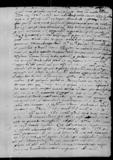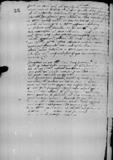Letter #7063
Ioannes DANTISCUS to Tiedemann GIESEs.l., [1539-05-25, postscripts 1539-05-26 and 1539-05-27]
English register:
Late the previous evening, when Dantiscus had finished writing his letter to Giese [this part of the letter is lost], a reply came from the King [Sigismund I Jagiellon] regarding the change of the time and place of the [Royal Prussian] Diet. Dantiscus is sending it to Giese. He thinks his extensively argued request, made on behalf of all the members of the [Prussian] Council, has not been considered in depth and the reply has been given as if he were asking solely on his own behalf. He sees the reason for this in the chancellery’s unwillingness to prepare new Diet memos. Therefore Dantiscus thinks it is necessary to set a new time and place for the meeting and consider whether the King needs to be asked for his consent again.
He proposes the Diet be summoned for June 15 or sooner in Marienburg (Malbork), and if the danger of the plague does not pass – in another, safer place. He asks the addressee and neighbouring lords for their opinion on this. He himself will ask for the opinion of the Voivode of Marienburg (Malbork) [Georg von Baysen (Jerzy Bażyński)], the Castellan of Gdańsk (Danzig) [Achatius von Zehmen (Cema)], the Elbing (Elbląg) Town Council, and the Gdańsk Town Council.
The Vice-Chancellor [Samuel Maciejowski] has written that, according to the King, the matter of the accounting of the contributions was exhausted in earlier instructions.
Dantiscus encloses the news he received. He prays for God to restore the addressee to good health. He thinks that if Giese is absent, the Diet cannot possibly have a good outcome.
After finishing the first postscript, Dantiscus received Giese’s letter with the good news of his restored health. Dantiscus expresses his joy and also the hope that disease will now hit those who wish Giese ill and are the cause of his troubles. He declares his support against Giese’s adversaries at the next Diet.
The Duke [Albrecht I von Hohenzollern-Ansbach] informed Dantiscus before St. Stanislaus’ Day [May 8] that the King commanded him to send his envoys to the [Prussian] Diet, something he was unable to do, so he asked for the designation of a few [Royal Prussian] councillors he could meet with or contact through emissaries. Dantiscus informed him that the Diet had been moved because of the plague and promised to inform him of the new time and place. He asks Giese also to consult neighbouring lords on the matter.
He sends Giese the Duke’s letter and the thing that the Duke wanted Giese to read. The first ratification is in the hands of the Thorn (Toruń) Town Council. Giese can have them deliver it to the Diet.
[Mikołaj] Płotowski will explain to Giese why he did not leave Dantiscus the previous day.
Manuscript sources:
Prints:
| ||||||
Text & apparatus & commentary Plain text Text & commentary Text & apparatus Excerpts concerning Dantiscus' travels
Postscript No. 1:
Cum has pridie maerens absolvissem, sera iam nocte
Ineundum igitur novum nobis erit consilium, ubi et quando nobis sit conveniendum, et si hoc ex nobis ipsis sit statuendum, an iterum pro consensu ad
De ratione contributionis scribit mihi reverendus dominus
Quae ad me nova cf.
Postscript No. 2:
Reverendissime mi Domine.
Cum ab hac scheda commodum manum amovissem, adfu[it]
cf.
Remitto ea, quae
illustrissimus
dominus
Heri dominus
[1 ] On May 25 Dantiscus received several letters from
[2 ] Only one of four letters mentioned here has been preserved – from Dantiscus to the
[3 ] We do not know of any letter from

